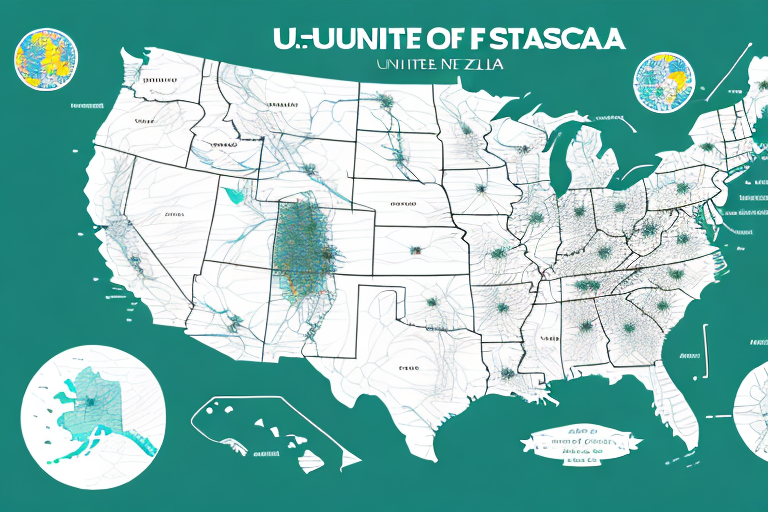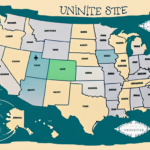Understanding UPS Shipping Rates for Zones 1-9
If you’re looking to ship anything using UPS, it’s crucial to understand the various factors that affect shipping rates, including shipping zones. UPS shipping rates are calculated based on a combination of distance, package weight and dimensions, package value, and destination type. In this article, we provide an in-depth analysis of UPS shipping rates for Zones 1-9, incorporating the latest data and insights to help you make informed decisions.
What Are UPS Shipping Zones?
UPS divides every delivery destination into 9 zones that correspond to the distance from your shipping location. The distance is calculated based on the number of shipping zones a package travels through before reaching its destination. Zone 1 covers nearby zip codes, while Zone 9 covers the furthest ones. The greater the number of zones a package crosses, the higher the UPS shipping rate. This means that shipping costs may vary depending on the destination of the packaged item, along with other factors.
It is important to note that UPS shipping zones are not solely based on distance. Other factors that influence shipping rates include package weight, size, and the type of service selected. For example, shipping a large, heavy package using UPS Ground service may be more expensive compared to a smaller package shipped via UPS SurePost service. Therefore, it is essential to consider all these factors when calculating the shipping cost for your package.
How Are UPS Shipping Rates Calculated?
UPS shipping rates are determined by a combination of three primary factors: package weight, package dimensions, and shipping distance. Generally, shipping rates increase with the weight and size of the package, as well as the distance it needs to travel. According to UPS’s 2023 shipping rate guide, optimizing package weight by consolidating shipments can lead to significant cost savings.
Additionally, UPS offers various shipping options that can impact the cost of your shipment. Selecting a faster delivery time or adding insurance to your package will increase the shipping rate, while opting for a slower delivery time or dropping off your package at a UPS location instead of scheduling a pickup can lower the shipping rate. It's important to weigh these options against your delivery needs and budget to choose the most cost-effective solution.
What Factors Affect UPS Shipping Rates?
Several factors can affect UPS shipping rates, including:
- Package Size and Weight: Larger and heavier packages typically incur higher shipping costs.
- Shipping Speed: Expedited services cost more than standard options.
- Destination Type: Commercial destinations often have lower rates compared to residential ones.
- Fuel Prices: Fluctuations in fuel costs can impact shipping rates.
- Air Transport Capacity: Limited capacity can drive up costs during peak times.
- Seasonal Surcharges: High-demand periods, such as holidays, may result in additional fees.
While distance remains the primary factor influencing shipping costs, these additional elements can significantly affect the overall rate. Understanding these variables can help you better anticipate and manage your shipping expenses.
Moreover, UPS provides various discounts and promotions throughout the year. Frequent shippers may qualify for volume discounts or special rates based on their shipping history. Seasonal promotions, particularly during peak periods, can also offer cost-saving opportunities.
How Does Distance Impact UPS Shipping Rates?
Distance is the most significant determinant of UPS shipping rates. The further a package has to travel, the higher the shipping cost. For instance, shipping from New York to California spans more zones and thus incurs higher fees compared to shipping within the same state.
In 2023, data indicates that the average shipping rate increases by approximately 5% for every additional zone crossed. Additionally, the type of service selected plays a crucial role; expedited shipping options will generally cost more than standard shipping options, even for the same distance.
Peak seasons, such as the holiday period, can also drive up shipping rates due to increased demand. To manage costs effectively, utilize UPS's online tools and resources to estimate shipping costs based on distance, package size, weight, and other factors. This allows for informed decision-making and potential savings on shipping expenditures.
What Is the Difference Between Residential and Commercial Shipping Rates?
UPS categorizes shipping destinations into two main types: commercial and residential. Commercial destinations include non-residential locations such as office buildings, factories, and industrial parks, whereas residential destinations are homes, apartments, and condos.
Shipping rates for commercial destinations are typically lower than those for residential destinations. This difference arises from several factors:
- Access and Delivery Efficiency: Commercial locations are generally easier to access and require less time for delivery drivers.
- Shipment Volume: Commercial shipments are often larger and more frequent, allowing carriers to achieve economies of scale.
- Handling Requirements: Residential deliveries may require specialized services like lift-gate delivery or inside delivery, which incur additional fees.
Understanding the distinction between residential and commercial shipping rates is essential for businesses and individuals when selecting the most appropriate shipping option for their needs.
How Do Package Size and Weight Affect UPS Shipping Rates?
Package size and weight are critical factors that influence UPS shipping rates. Heavier and larger packages generally cost more to ship than smaller and lighter ones. UPS calculates shipping rates using a formula that includes both actual weight and dimensional weight (dim weight).
Dimensional Weight Pricing: UPS employs a dimensional weight pricing system for packages that are larger than standard sizes. This method calculates the shipping rate based on the package’s volume rather than just its weight, ensuring that larger packages that take up more space on delivery trucks or planes are appropriately priced.
For example, a package measuring 20x20x20 inches with a lower actual weight may be priced higher due to its large size. Therefore, accurately measuring and calculating your package’s dimensional weight is vital to avoid unexpected charges.
Additionally, the shipping distance plays a role in determining the overall cost. The farther the package travels, the more expensive the shipping rate will be. Choosing the right shipping service, whether expedited or standard, further impacts the final cost.
Destination also matters, as international shipments may include additional taxes, duties, and fees, increasing the overall shipping cost. It’s advisable to consider all these factors when planning your shipments to optimize costs effectively.
Understanding the Importance of Dim Weight Pricing
UPS utilizes a dimensional weight pricing system for packages that exceed standard dimensions. Instead of relying solely on the package's actual weight, the shipping rate is determined based on the package’s dimensional weight. This approach ensures that shipping costs reflect both the weight and the space the package occupies, promoting efficiency in transportation.
For instance, a large, lightweight package may have a higher dimensional weight than its actual weight, resulting in a higher shipping rate. Therefore, accurately measuring and calculating your package’s dimensional weight is crucial to avoid unexpected fees.
Moreover, dimensional weight pricing is a common practice among many shipping carriers, not just UPS. This method allows carriers to account for the space a package takes up on delivery vehicles and aircraft, ensuring that shipping costs remain fair and competitive.
By understanding and leveraging dimensional weight pricing, businesses can optimize their packaging strategies, potentially reducing shipping costs while maintaining the integrity and safety of their shipments.
Tips for Reducing UPS Shipping Costs
Reducing UPS shipping costs can significantly impact your overall business expenses. Here are some effective strategies:
- Consolidate Shipments: Combine multiple items into a single shipment to take advantage of multi-piece shipment discounts.
- Accurate Measurements: Ensure your package dimensions and weights are accurately measured to avoid additional fees.
- Choose the Right Shipping Method: Select the most cost-effective shipping option that meets your delivery requirements.
- Leverage UPS Tools: Utilize UPS’s online tools to find the best rates and optimize your shipping strategy.
Comparing UPS Shipping Rates with Other Carriers
Another effective tactic for reducing shipping costs is to compare UPS shipping rates with those of other carriers such as FedEx, DHL, and the United States Postal Service (USPS). By evaluating different rates, you can identify the most cost-effective shipping option that suits your budget and specific shipping needs.
However, it’s important to consider more than just the price. Factors such as delivery speed, reliability, and additional services should also be weighed to ensure you’re selecting the best carrier for your particular situation. Sometimes, the cheapest option may not provide the level of service required, potentially affecting customer satisfaction.
Using comparison tools and services can streamline this process, allowing you to make informed decisions and optimize your shipping expenses effectively.
Understanding the Benefits of Using a Third-Party Logistics Provider (3PL)
A third-party logistics provider (3PL) can play a pivotal role in reducing your overall shipping costs. By partnering with a 3PL, you gain access to negotiated contract terms with carriers, consolidated shipments, and expert advice on optimizing your shipping strategy.
A reliable 3PL partner can offer valuable insights and recommendations on the best shipping options for your business, streamline the shipping and fulfillment process, and help keep shipping costs in check. Additionally, 3PLs often have access to advanced technology and analytics tools that can further enhance your shipping efficiency and cost-effectiveness.
How to Choose the Right Packaging and Materials for Your Shipment
Selecting the appropriate packaging and materials is essential for reducing shipping costs and ensuring the safe delivery of your items. Here are some tips:
- Use Sturdy, Lightweight Packaging: Choose packaging that is both durable and lightweight to prevent damage and avoid overweight fees.
- Optimize Package Size: Ensure that the package is the right size for the contents to minimize dimensional weight charges.
- Eco-Friendly Materials: Opt for packaging materials that are renewable, biodegradable, or made from recycled content to reduce waste and potentially qualify for greener shipping discounts.
- Reinforce Packages: Properly reinforce packages to protect against rough handling during transit, reducing the likelihood of damage and returns.
Investing in high-quality packaging not only safeguards your products but also contributes to more efficient and cost-effective shipping practices.
Navigating the UPS Online Shipping Platform
The UPS online shipping platform is a valuable tool for managing and tracking your shipping operations efficiently. The platform offers a range of features, including:
- Shipping Labels: Easily create and print shipping labels for your packages.
- Rate Quotes: Obtain instant shipping rate quotes based on your package details and desired service levels.
- Package Tracking: Monitor the status of your shipments in real-time.
- Package Pickups: Schedule pickups directly from your location to streamline the shipping process.
By familiarizing yourself with the UPS online shipping platform, you can optimize your shipping workflow, enhance tracking capabilities, and potentially reduce shipping costs through better management and utilization of available features.
Common Mistakes to Avoid When Estimating UPS Shipping Costs
Accurate estimation of UPS shipping costs is vital for budgeting and customer satisfaction. Here are common mistakes to avoid:
- Ignoring Dimensional Weight: Failing to account for dimensional weight can lead to unexpected higher shipping costs.
- Incorrect Measurements: Not properly measuring package dimensions and weight can result in inaccurate rate estimates.
- Overlooking Carrier Cutoff Times: Missing carrier cutoff times may necessitate expedited shipping, increasing costs.
- Misunderstanding Shipping Categories: Confusing commercial and residential shipping rates can lead to overpayment.
To ensure accurate shipping cost estimates, carefully calculate your package’s dimensions and weight, and double-check all shipping quotes and rates using UPS’s online tools.
How to Handle Disputes with UPS Over Shipping Charges
If you encounter a dispute with UPS regarding shipping charges, it’s important to address the issue promptly and effectively. Here are steps to handle such disputes:
- Contact UPS Customer Service: Reach out to your UPS representative directly to discuss and resolve the issue.
- Provide Documentation: Have all relevant shipping documents, invoices, and proof of service ready to support your claim.
- File a Formal Complaint: If direct communication does not resolve the issue, consider filing a complaint with the Better Business Bureau or other regulatory agencies.
- Review Terms and Conditions: Familiarize yourself with UPS’s terms and conditions to ensure your dispute is valid and within policy guidelines.
Effective communication and thorough documentation are key to resolving disputes efficiently and maintaining a positive relationship with UPS.
Leveraging Discounts and Promotions to Save on UPS Shipping Costs
Maximizing savings on UPS shipping costs can be achieved by taking advantage of available discounts and promotions. Here are some strategies:
- Volume Discounts: Frequent shippers may qualify for discounted rates based on shipping volume.
- Referral Programs: Participate in referral programs to earn discounts or credits towards future shipments.
- Seasonal Promotions: Take advantage of seasonal discounts, especially during peak shipping periods like holidays.
- Promotional Codes: Utilize promotional codes offered by UPS and partners to receive additional savings.
Consult with your UPS representative to identify and enroll in programs that best suit your shipping needs and can provide the most significant cost savings.
The Future of UPS Shipping: Trends and Innovations to Watch Out For
Looking ahead, the UPS shipping industry is poised to continue evolving in response to technological advancements and changing consumer behaviors. Key trends and innovations to watch include:
- Growth of E-commerce: The increasing prevalence of online shopping is driving demand for more efficient and scalable shipping solutions.
- Automation and Robotics: Enhanced automation in warehouses and sorting facilities is improving shipping speed and accuracy.
- Emergence of Drones and Autonomous Vehicles: Innovations in unmanned delivery systems could revolutionize last-mile delivery, reducing costs and delivery times.
- Sustainable Shipping Practices: There is a growing emphasis on eco-friendly shipping options, including the use of electric vehicles and sustainable packaging materials.
- Advanced Tracking and AI: Improved tracking technologies and artificial intelligence are enhancing shipment visibility and predictive logistics.
Staying informed about these trends and incorporating relevant innovations into your shipping strategy can help you manage shipping costs effectively and stay competitive in the market.






















